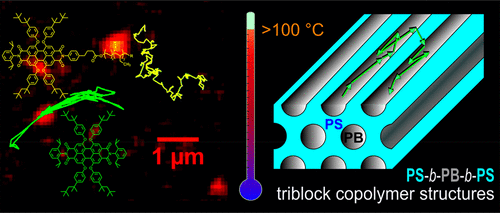当前位置:
X-MOL 学术
›
Macromolecules
›
论文详情
Our official English website, www.x-mol.net, welcomes your
feedback! (Note: you will need to create a separate account there.)
Diffusion of Molecular and Macromolecular Polyolefin Probes in Cylindrical Block Copolymer Structures As Observed by High Temperature Single Molecule Fluorescence Microscopy
Macromolecules ( IF 5.1 ) Pub Date : 2018-02-22 00:00:00 , DOI: 10.1021/acs.macromol.8b00071 Moritz Baier 1 , Dominik Wöll 2 , Stefan Mecking 1
Macromolecules ( IF 5.1 ) Pub Date : 2018-02-22 00:00:00 , DOI: 10.1021/acs.macromol.8b00071 Moritz Baier 1 , Dominik Wöll 2 , Stefan Mecking 1
Affiliation

|
Highly sensitive fluorescence microscopy methods allow for the observation of single bright fluorescent probes. Analysis of their trajectories gives access to the mode of diffusion and the heterogeneity in motion of individual probes. Especially for structured soft materials, this information is of paramount importance for a multitude of possible applications such as nanoelectronics, nanophotonics, or nanomembrane technology. Compared to biological systems, utilization for materials research faces the challenge that relevant processes occur at elevated temperature, often above 100 °C, and that fluorescence labeling procedures are yet less evolved. We investigated the motion of single probes in block copolymer morphologies from room temperature to over 100 °C with a custom-made heating device to allow for such high temperatures without damaging the optics of a commercial optical microscope and also with the possibility to measure under a nitrogen atmosphere to reduce photobleaching of the dyes. Apart from tracking single perylenediimide derivative as a molecular probe, we labeled polyolefin chains with this chromophore and observed their diffusion. For the synthesis of the polyolefins, as the most important class of polymeric materials in general, we present a protocol that provides high quality samples in terms of molecular weights, molecular weight distributions, and proven degree of dye functionalization. The dependency of temperature, block copolymer composition, and probe size on the diffusion behavior is elaborated.
中文翻译:

高温单分子荧光显微镜观察到的分子和大分子聚烯烃探针在圆柱形嵌段共聚物结构中的扩散。
高度灵敏的荧光显微镜方法可用于观察单个明亮的荧光探针。通过分析其轨迹,可以了解扩散模式和各个探针运动的异质性。尤其对于结构化的软材料,此信息对于诸如纳米电子学,纳米光子学或纳米膜技术等多种可能的应用至关重要。与生物系统相比,材料研究的利用面临着以下挑战:相关过程通常在高于100°C的高温下发生,并且荧光标记程序发展得很少。我们使用定制的加热装置研究了从室温到超过100°C的嵌段共聚物形态中单个探针的运动,以允许如此高的温度而不会损坏商业光学显微镜的光学器件,并且还可能在室温下进行测量。在氮气气氛中减少染料的光漂白。除了跟踪单个per二酰亚胺衍生物作为分子探针外,我们用该生色团标记了聚烯烃链并观察了它们的扩散。对于聚烯烃的合成,作为一般最重要的聚合材料,我们提供了一种协议,该协议可提供有关分子量,分子量分布和已证明的染料官能化程度的高质量样品。温度的依赖性,嵌段共聚物的组成,
更新日期:2018-02-22
中文翻译:

高温单分子荧光显微镜观察到的分子和大分子聚烯烃探针在圆柱形嵌段共聚物结构中的扩散。
高度灵敏的荧光显微镜方法可用于观察单个明亮的荧光探针。通过分析其轨迹,可以了解扩散模式和各个探针运动的异质性。尤其对于结构化的软材料,此信息对于诸如纳米电子学,纳米光子学或纳米膜技术等多种可能的应用至关重要。与生物系统相比,材料研究的利用面临着以下挑战:相关过程通常在高于100°C的高温下发生,并且荧光标记程序发展得很少。我们使用定制的加热装置研究了从室温到超过100°C的嵌段共聚物形态中单个探针的运动,以允许如此高的温度而不会损坏商业光学显微镜的光学器件,并且还可能在室温下进行测量。在氮气气氛中减少染料的光漂白。除了跟踪单个per二酰亚胺衍生物作为分子探针外,我们用该生色团标记了聚烯烃链并观察了它们的扩散。对于聚烯烃的合成,作为一般最重要的聚合材料,我们提供了一种协议,该协议可提供有关分子量,分子量分布和已证明的染料官能化程度的高质量样品。温度的依赖性,嵌段共聚物的组成,











































 京公网安备 11010802027423号
京公网安备 11010802027423号